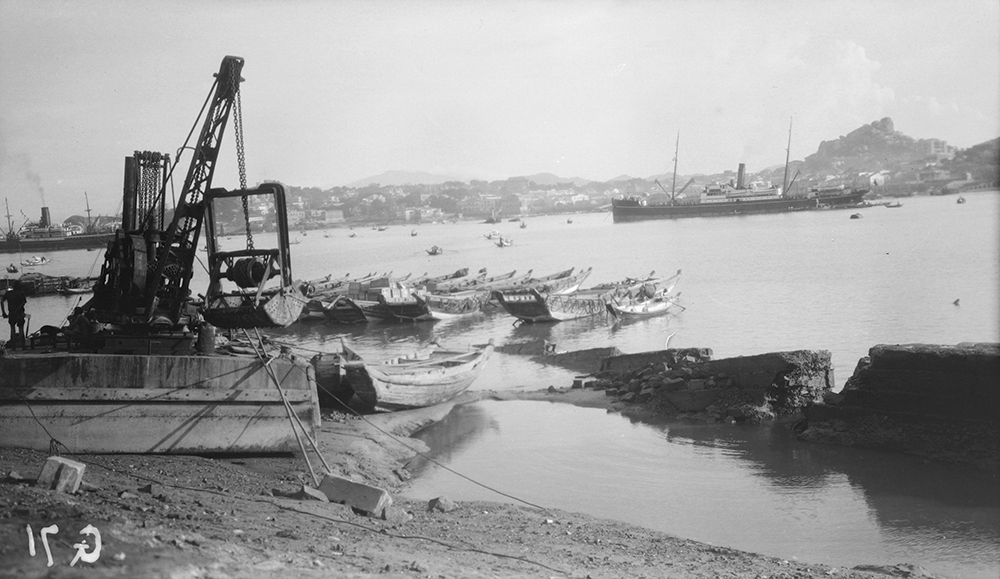Our latest guest blog comes from David Woodbridge, who received his PhD from the University of Manchester. He was subsequently a postdoctoral fellow at Xiamen University, where he worked with the Gulangyu International Research Centre. He is currently working at the John Rylands Research Institute, at the University of Manchester, where, supported by a British Inter-university China Centre Cultural Engagement Fellowship, he is looking at the Chinese collections in the John Rylands Library.

Reclamation works at Amoy, c.1921, by Warren Swire: G.W. Swire collection, sw07-102 © 2007 John Swire & Sons Ltd
This photograph, taken in 1920, provides an interesting insight into Xiamen’s distinctive semi-colonial arrangements. As one of the original five treaty ports, Xiamen (Amoy) acquired a British Concession in 1852. This consisted of a stretch of foreshore about 200 metres long and 70 metres wide, running along the harbour front, and housing the offices and warehouses of the foreign businesses that operated in the city. The photo is taken looking out from this Concession, across the old harbour. In the distance can be seen the island of Gulangyu (Kulangsu). Covering an area of around 2km², this small island became the preferred place of residence for Xiamen’s modestly-sized foreign community. Xiamen itself, and particularly its walled city, had quickly gained a reputation among foreigners for being dirty and disease-ridden. Therefore, Gulangyu, being in close proximity to the harbour but separate from it, became the favoured site for foreigners to make their home.
In the years that followed, Gulangyu’s foreign community increasingly sought powers to shape the development of the island in a manner more to their liking. Finally, in 1903, the Qing agreed to reconstitute Gulangyu as an international settlement. This was modelled on the international settlement in Shanghai, with the governance to be in the hands of a municipal council elected by local ratepayers. Unlike in Shanghai, however, provision was made for Chinese representation, with one Chinese councillor to sit alongside the five to six foreign councillors. This new arrangement was viewed by many as embodying a more progressive model for the ordering of Sino-foreign relations.

Gulangyu in the late 1880s, J.O. Oswald Collection Os01-021. Photo from an album kept in the School of Oriental and African Studies Archives, London (SOAS reference MS 380 876/1) © 2008 SOAS
Under this new regime Gulangyu’s development proceeded apace, with modern infrastructure and facilities being put in place. In addition, the island’s status kept it outside of the fierce feuding that afflicted southern Fujian during the warlord era. Consequently, Gulangyu’s population grew, and the new arrivals included many Chinese businessmen returning from Southeast Asia, whose wealth became embodied in large and elaborate residences on the island.
Meanwhile, the British Concession was increasingly becoming a site of contention. Beginning in the 1870s, attempts were made at land reclamation immediately in front of the Concession, something captured in the first photograph, above. The legal status of the reclaimed land was ambiguous, and in 1921 it became the source of a dispute that led to a boycott of Butterfield & Swire, who had sought to construct a pier connecting their lot in the Concession directly to the harbour. The boycott spread to Shanghai and Shantou, and resulted in an embarrassing climb-down by the British authorities, who had to retreat from their original, hard-line opposition to the protesters.
Gulangyu also became targeted by anti-imperialist protests. Chinese representation on the municipal council, while originally intended as a progressive measure, became a source of grievance, as protesters campaigned for a balance of representation on the council that better reflected the larger Chinese population on the island. The number of Chinese councillors was increased to three in 1927, but tensions remained in the international settlement’s administration.

Amoy new bund in front of the former British Concession, following completion of reclamation work, 1933, by Warren Swire, G.W. Swire collection sw08-089 © 2007 John Swire & Sons Ltd.
The British Concession in Xiamen was returned to Chinese rule in 1930, one of a number of concessions given up as the British sought to reduce its colonial presence in China in the wake of the Nationalist Revolution. Gulangyu, however, remained an international settlement until 1941. Its population of Americans, Europeans and Japanese, as well as local and overseas Chinese, produced a unique political and cultural character that made it one of the more eclectic of China’s colonial spaces during the Republican period.

